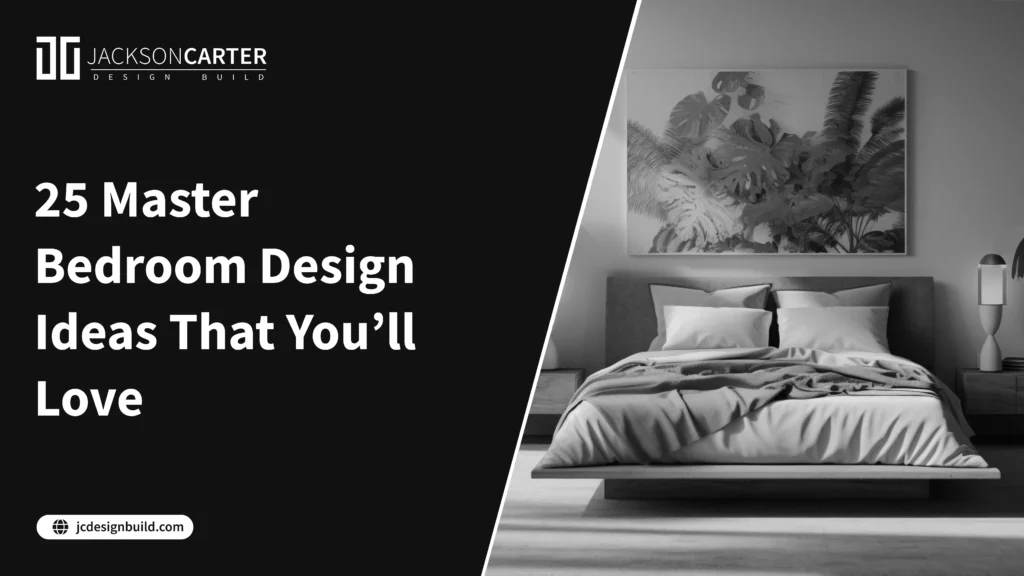Designing your master bedroom is more than a functional exercise—it’s a deep dive into personal expression, comfort, and a chance to indulge in your favorite aesthetics.
Think back to the days of decorating your MySpace wall, when you’d plaster it with heartfelt lyrics from your favorite pop or “sobby” tunes. Well, decorating your bedroom is a lot like that, but with a grown-up twist. Just as you once curated that digital space to reflect your tastes, your master bedroom now offers a real-life canvas to showcase your personality in a more sophisticated, comfortable way.
Now, it doesn’t matter if your taste leans towards modern minimalism, classic elegance, or bold, eclectic flair—you can transform your primary sleeping quarters into a luxurious retreat that’s both uniquely you and undeniably cozy. In this blog, you’ll find 25 detailed and creative ideas to inspire your next bedroom makeover. You might choose to integrate a single element, or maybe you’ll embark on a complete overhaul. Each concept comes with practical tips to help bring your dream room to life. And if you find a design you absolutely love and want to recreate it perfectly, JCDB can help!
Let’s get started.
Best Master Bedroom Design Ideas in 2025
1. Vintage Vibes: The New Classics
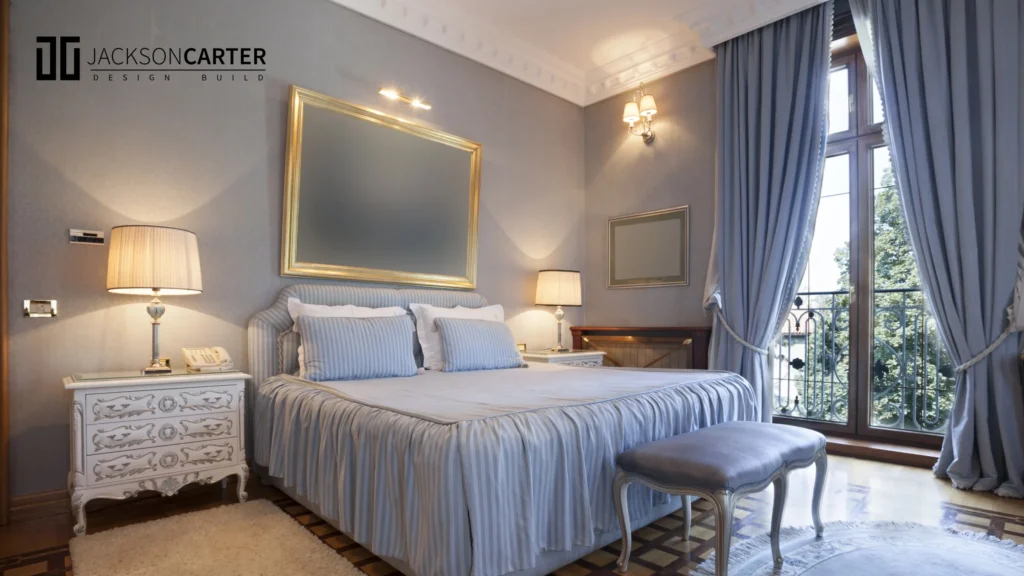
Balancing vintage flair with contemporary touches is a testament to timeless style. By intentionally blending pieces from different eras, you can create a master bedroom that’s visually compelling and full of character. For instance, a sleek, mid-century modern nightstand could sit alongside an ornate, baroque-style mirror, creating a space that acknowledges history while embracing the future.
How to Achieve It?
- Layered Lighting: Introduce a retro chandelier or a vintage pendant lamp. The style can be anything from a crystal-adorned chandelier for opulence to a classic brass sputnik fixture for a more modernist appeal. Combine it with recessed lighting or sleek floor lamps to achieve functional layering.
- Textural Play: Consider mixing different fabrics, such as a velvet bench with a simple cotton duvet. You could also place an antique rug under your bed to add heritage and texture.
- Artful Displays: Showcase vintage artworks or framed botanical prints alongside more modern abstract pieces. The result is an eclectic blend that makes your wall space feel curated rather than cluttered.
- Strategic Color Palette: Earthy neutrals like beige, taupe, or mushroom can allow vintage wooden elements or old-world metal finishes to shine without overwhelming the room.
Quick Tips
- Select a Statement Piece: Let one vintage item—like a distressed armoire—be the star. Everything else should complement it rather than compete.
- Neutral Foundations: Tune walls and large pieces of furniture to highlight antiques.
- Modern Contrast: Incorporate contemporary, clean-lined items (like minimalist lamps) to emphasize the beauty of older, ornate pieces.
- Edit Thoughtfully: Resist the urge to overcrowd the space with too many vintage elements; balance is key.
2. Crimson Appeal: Go Dramatic With Red
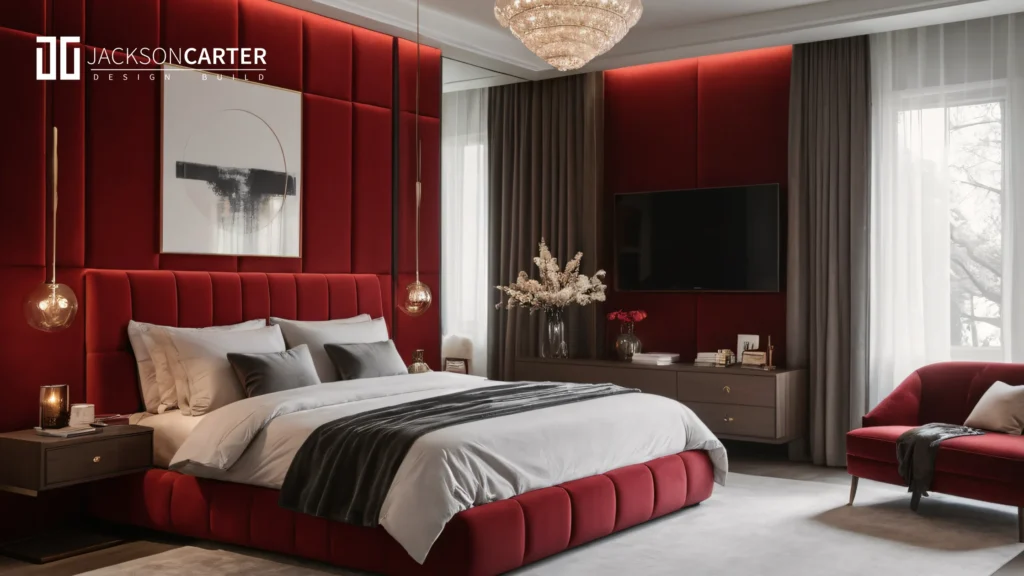
When it comes to color psychology, red is often associated with passion and energy. In the bedroom, this vibrant hue can provide a jolt of excitement and warmth, especially when used strategically. If you’re drawn to drama and want your master bedroom to be anything but ordinary, crimson details can set the stage.
How to Achieve It?
- Accent Wall: Paint just one wall in a rich, dramatic red. This instantly draws the eye and creates an energetic focal point without overwhelming the space.
- Layering Textiles: Incorporate shades of red through throw blankets, cushions, or even a plush rug. Multiple tones—think burgundy, brick, or cherry—add interest.
- Balancing Act: If red is too intense, temper it with neutrals such as beige, cream, or soft gray. Natural elements like wooden bedside tables or wicker baskets can also ground the bold color.
- Metallic Partners: Red pairs beautifully with gold or brass, amplifying the room’s sense of luxury.
Quick Tips
- Start Small: If you’re color-shy, introduce red via décor accents—like pillows or lampshades—before committing to a whole wall.
- Light Control: Red can feel even more dramatic in warm, dim lighting; use layered lighting solutions at night to shift the ambiance from energetic to soothing.
- Use Texture: A velvet chaise lounge or velvet throw pillows in red can bring color and softness to your space.
- Avoid Over-Saturation: Balance is crucial. Combine red with ample white space and subtle patterns.
3. Midnight Zen: The Somber Onyx Retreat
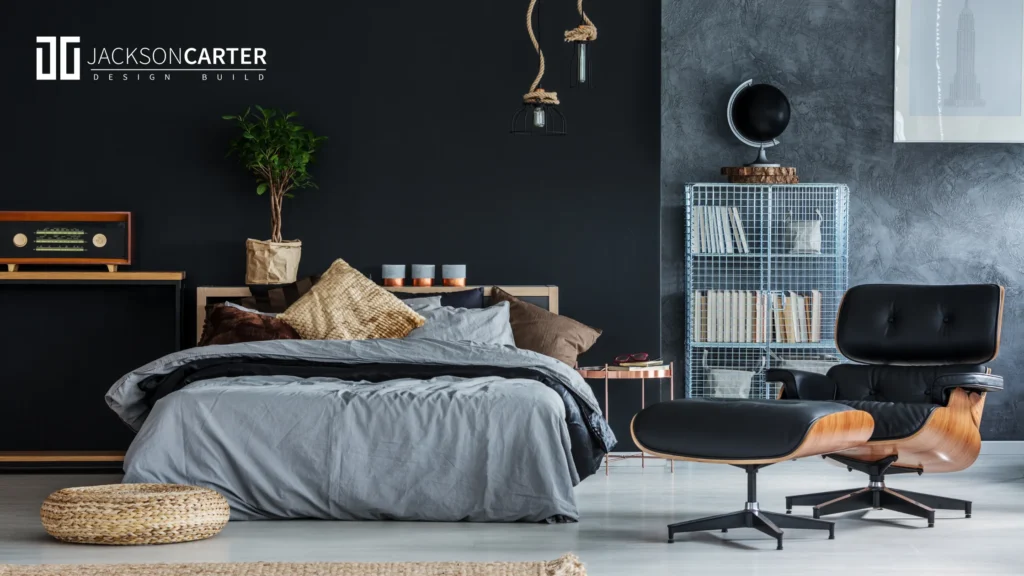
Dark color palettes can be surprisingly relaxing. By leaning into moody tones like onyx, charcoal, or espresso, you establish a cocoon-like ambiance that invites restful sleep. The key to making this look successful is to balance the darkness with textures and reflective accents so that your bedroom feels intimate rather than gloomy.
How to Achieve It?
- Contrast With Light Bedding: Crisp white or pale gray sheets pop against an inky backdrop, ensuring the bed remains the room’s star.
- Mirrored Furnishings: Incorporate mirrored dressers, metallic frames, or glass pendant lights to reflect natural light and keep the room from looking flat.
- Accent Lighting: Use soft, warm bulbs in table lamps or sconces to add a comforting glow that complements darker walls.
- Textural Layers: Plush rugs, faux fur throws, or knitted blankets in wooden-textural shades help break up large swaths of black.
Quick Tips
- Play With Patterns: Subtle geometric wallpaper or damask prints in black-on-black can add elegant texture.
- Add Greenery: A few indoor plants (like snake plants or rubber trees) offer a natural pop of color that enlivens dark corners.
- Strategic Furniture Placement: Avoid overcrowding. Allow some negative space so the dark walls can breathe.
- Balance With Metallics: Silver, gold, or brushed nickel hardware can feel especially luxe in a dark-hued setting.
4. Sunny Side Up: Light & Bright
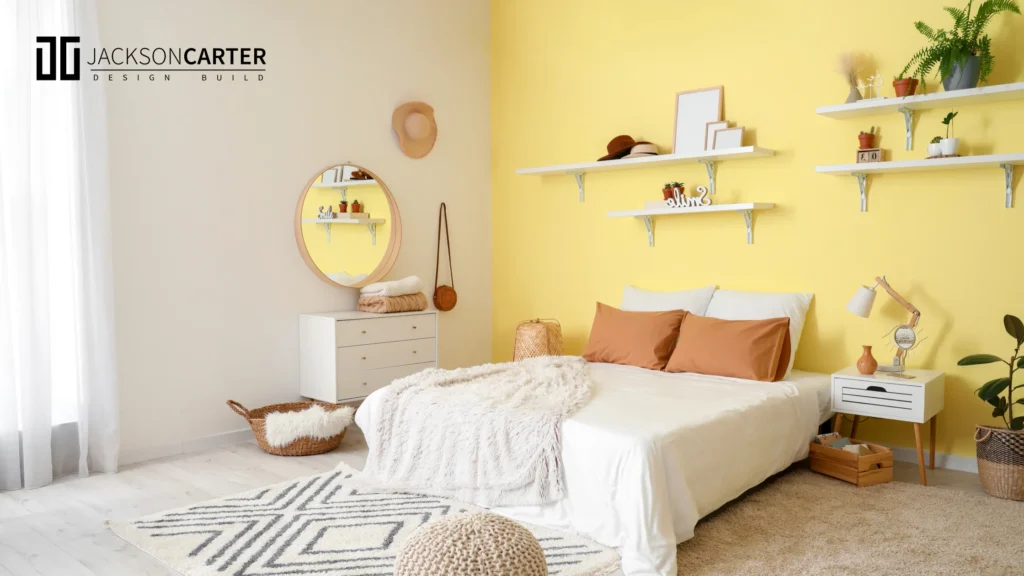
A master bedroom filled with light colors exudes serenity and spaciousness. White, cream, and pastel color schemes reflect natural light and create a tranquil retreat that helps you begin and end your day on a soft note.
How to Achieve It?
- Shades of White: To add subtle depth, combine ivory, eggshell, and off-white in layers—think bedding, drapery, and rugs.
- Pastel Pop: If all-white is too stark, use pastel blues, gentle lavenders, or mint greens as accent colors in throw pillows and artwork.
- Reflective Accents: Consider placing mirrors strategically to bounce daylight around the room, making it appear even brighter.
- Natural Textiles: Linen curtains and cotton quilts can emphasize the airy, breathable nature of the space.
Quick Tips
- Dimmer Switches: Control your lighting from bright and energetic during the day to calming at night.
- Minimalist Décor: Keep clutter to a minimum to let the light palette take center stage.
- Warm Metal Accents: Incorporate gold, brass, or rose gold elements for subtle warmth.
- Green Touches: Small potted plants thrive in well-lit environments, adding a refreshing contrast.
5. Trad Maximalism: Elevated Extravagance

For those who love a bit of grandeur, traditional maximalism marries classic elements—like ornate furniture and lavish fabrics—with an unapologetically layered style. Rather than aiming for minimalism, this approach embraces opulence, patterns, and sumptuous textures.
How to Achieve It?
- Textile Variety: Rich velvet drapes, brocade cushions, and silk sheets can coexist harmoniously if you keep your color palette somewhat unified.
- Detailed Furnishings: Seek out headboards with tufting, carved wood frames, or gold leaf detailing. Antique side tables and elaborately designed armoires further the sense of magnificence.
- Layered Accessories: Multiple throw pillows, layered rugs, and even a statement chandelier can be combined to make the space rich and inviting.
- Personal Flair: Display curated collections—like vintage perfume bottles, gilded picture frames, or classical sculptures—to add depth and narrative.
Quick Tips
- Cohesive Palette: Color coordination is essential even in maximalist styles. Choose a primary hue (emerald green or royal blue) and let other colors complement it.
- Strategic Patterns: Mix florals, damasks, and stripes. Aim for at least one unifying color across them.
- Focus on Quality: High-end finishes and materials resonate in a maximalist space—quality over quantity.
- Create Balance: Use negative space on walls or in corners to avoid visual overwhelm.
6. Earthy Enchantment: Natural Textures
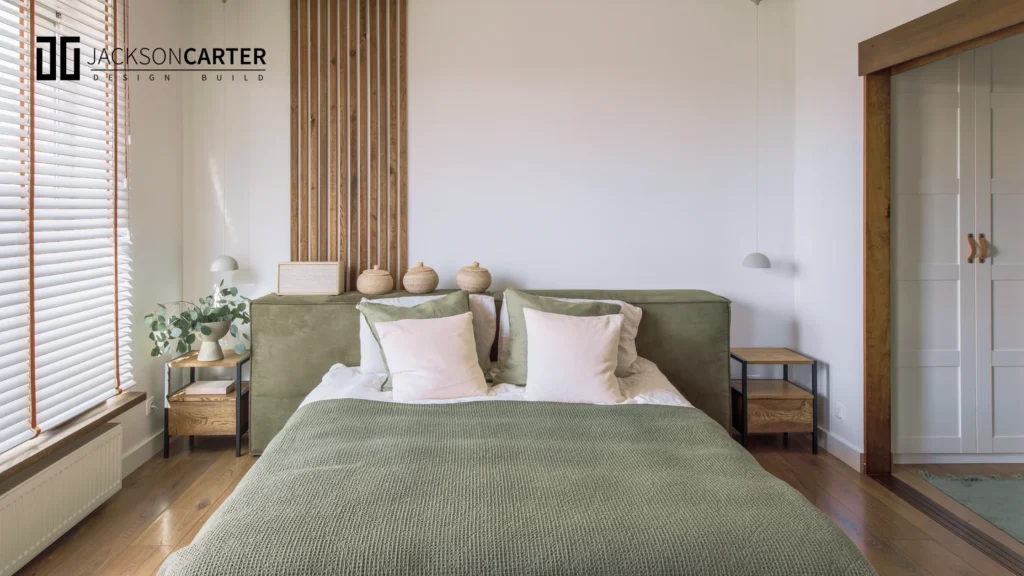
Nature-inspired designs are all about bringing in elements that echo the outdoors. Rattan furniture, jute rugs, cotton linens, and woven accents can add warmth and a sense of groundedness to your master bedroom.
How to Achieve It?
- Sustainable Choices: Look for eco-friendly materials like bamboo or sustainably sourced wood. These not only add character but also help the environment.
- Layered Textures: A braided jute rug paired with a light linen duvet and a chunky knit blanket creates a tactile wonderland.
- Organic Palette: Stick to earth tones like sand, clay, terracotta, and sage to reinforce nature’s soothing color spectrum.
- Botanical Accents: Integrate real or faux plants to enhance the earthy ambiance. Hanging macrame planters can introduce vertical interest.
Quick Tips
- Natural Light: Keep window treatments minimal to allow plenty of daylight, emphasizing the organic vibe.
- Textured Wall Hangings: Incorporate woven tapestries or macrame pieces for extra visual appeal.
- Earthy Aromas: Scented candles with notes of cedar, sandalwood, or fresh linen add sensory depth.
- Handcrafted Décor: On shelves, Handwoven baskets or artisanal pottery underline the natural theme.
7. Crowning Glory: Statement Ceilings

Your ceiling is a blank canvas often overlooked in design schemes. Adding a pop of color, intricate moldings, or even wallpaper on the ceiling can create a visually stunning “fifth wall” that demands attention.
How to Achieve It?
- Painted Contrast: Use a bold color on the ceiling while keeping walls neutral. This approach draws the eye upward without overloading the space.
- Patterned Wallpaper: Geometric designs, florals, or metallic starbursts can turn the ceiling into an artistic focal point.
- Coffered or Beamed Ceilings: If your home allows, exposed beams or coffered panels add architectural grandeur. Painted beams can be especially striking.
- Lighting Drama: Highlight your statement ceiling with a striking chandelier or pendant lights, creating a dual focal point.
Quick Tips
- Complementary Colors: Ensure the ceiling treatment complements your existing walls and bedding.
- Height Considerations: Dark or heavily patterned ceilings work best in rooms with higher ceilings; otherwise, it might feel cramped.
- Lighting Placement: Plan your lighting scheme before committing to the ceiling design to avoid awkward fixture placements.
- Opt for Quality Materials: Proper installation is crucial for looking polished on ceiling wallpapers or moldings.
8. Cozy Cocoon: The Canopy Comfort

A canopy bed can evoke fairytale romance and timeless elegance. By draping airy fabric around your sleeping area, you create a private haven that shields you from outside distractions.
How to Achieve It?
- Fabric Choices: Light, sheer curtains offer a dreamy vibe, but heavier drapes in velvet or linen can provide a more dramatic, luxurious feel.
- Frame Designs: Canopy frames range from minimalist metal structures to ornate wooden four-posters. Select a style that resonates with your overall décor.
- String Lights: For a whimsical touch, weave fairy lights or LED strands through the canopy, offering a soft glow when it’s time to unwind.
- Color Coordination: Coordinate canopy fabrics with your bedding. Shades of white or pastel evoke a softer look, while jewel tones radiate richness.
Quick Tips
- Ceiling Height Check: Higher ceilings are best for full-canopy designs, though half-canopy or partial drapes can also work in smaller rooms.
- Regular Maintenance: Sheer fabric can accumulate dust quickly, so be prepared for occasional washing or vacuuming.
- Add Personal Accents: Hang small trinkets or dream catchers from the canopy frame for extra personalization.
- Balance Surroundings: Pair a canopy bed with simpler side tables so the bed remains the focal point.
9. Rustic Edge: Shiplap Contrast

Shiplap walls bring a cozy, farmhouse vibe to your master bedroom. By painting shiplap in contrasting colors—like crisp white shiplap against a dark accent wall—you emphasize textures and lines, making the space feel welcoming yet stylish.
How to Achieve It?
- Mixed Materials: Combine shiplap with stone or exposed brick for a layered, rustic-industrial aesthetic.
- Modern Farmhouse Twist: Pair shiplap walls with sleek, contemporary furniture. This contrast ensures the room doesn’t feel too old-fashioned.
- Paint Choice: White shiplap is classic, but for a modern spin, experiment with deeper shades like navy or charcoal.
- Ceiling Shiplap: Extend the shiplap treatment to the ceiling for a cohesive, enveloping feel.
Quick Tips
- Proper Installation: Ensure boards are level and well-sealed, especially if you live in a humid climate.
- Neutral Accents: Soft greige or beige textiles can complement the natural warmth of wood.
- Coordinate Hardware: Black iron or matte gold fixtures pair well with rustic elements.
- Avoid Overdoing It: Balance your rustic wall with contemporary décor, so it doesn’t become overly themed.
10. Wallpaper Wonderland
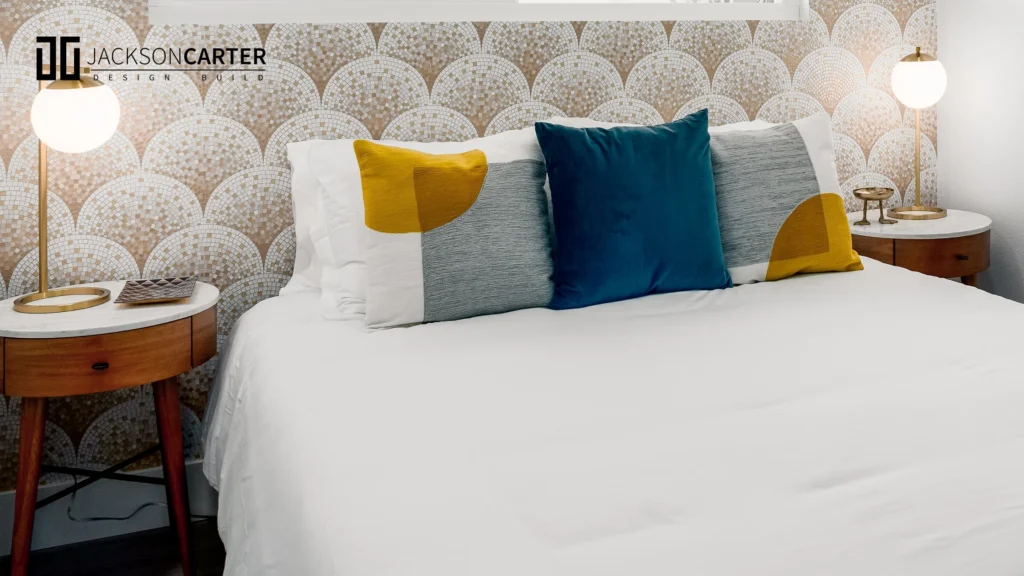
Wallpapers have evolved from grandma’s florals to modern, removable designs and endless patterns—geometrics, botanicals, abstract art, you name it. This versatility makes wallpaper a go-to for those looking to make a strong style statement.
How to Achieve It?
- Full-Wall Impact: Cover all walls in a bold pattern to make the entire room feel immersive.
- Feature Wall: If full coverage feels too intense, wallpaper just one focal wall—often behind the headboard—to create a visually arresting backdrop.
- Layering Decor: Use the wallpaper’s primary color in your accessories to tie the room together.
- Removable Varieties: If you like changing your décor, removable wallpaper lets you experiment without long-term commitment.
Quick Tips
- Pattern Scale: Large motifs make a big statement in spacious rooms, while smaller patterns suit cozier spaces.
- Quality Over Quantity: Invest in high-quality wallpaper to avoid peeling or fading.
- Coordinate Fabrics: Match or complement the wallpaper’s colors in your bed linens and throw pillows.
- Wall Prep: Smooth, clean walls ensure the best adhesion and finish.
11. Faux Fabulous: Painted Headboard Illusion
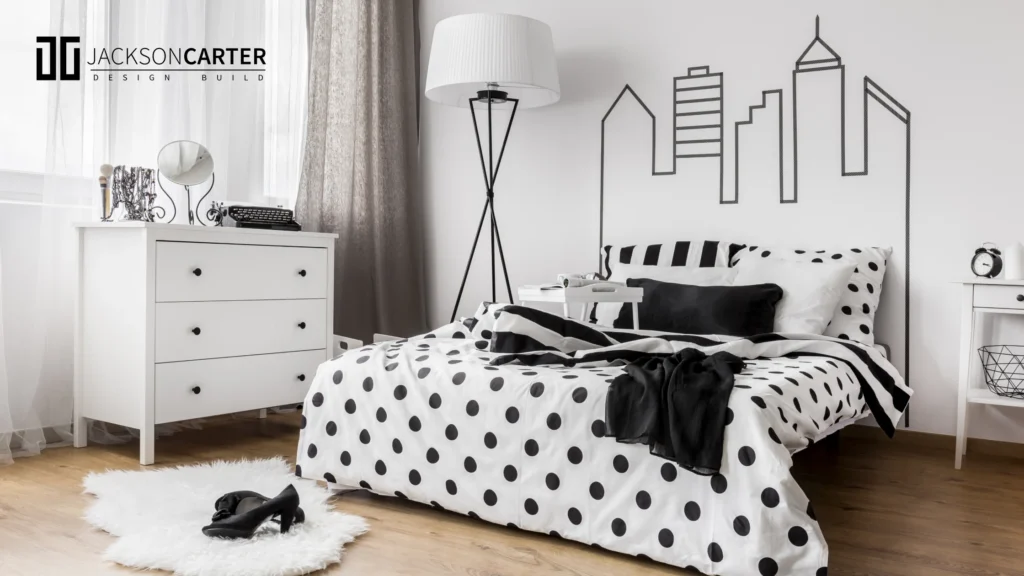
Instead of investing in a large, possibly expensive headboard, painting one directly on your wall can be an artful, budget-friendly solution. You can create anything from a classic rectangular panel to a whimsical arch with painter’s tape, stencils, and the right paint.
How to Achieve It?
- Color Blocking: Use two contrasting paint colors to define the “headboard” shape. If your wall is white, choose a bold color or vice versa.
- Geometric Designs: Go beyond simple shapes by stenciling intricate geometric patterns for a more contemporary flair.
- Texture Simulation: To mimic wood grain or fabric, use faux-finish painting techniques or specialized stencils.
- Scale & Proportion: To achieve a balanced look, make sure the painted shape aligns with your bed’s width and height.
Quick Tips
- Use Quality Tape: This ensures clean edges and professional results.
- Protect Your Bed: Move furniture away or cover it before painting to avoid accidental drips.
- Match Bedding: Harmonize the color palette with your duvet or pillows to tie the design together.
- Maintenance Ease: Repainting is simple if you ever want a new look.
12. Paneled Perfection
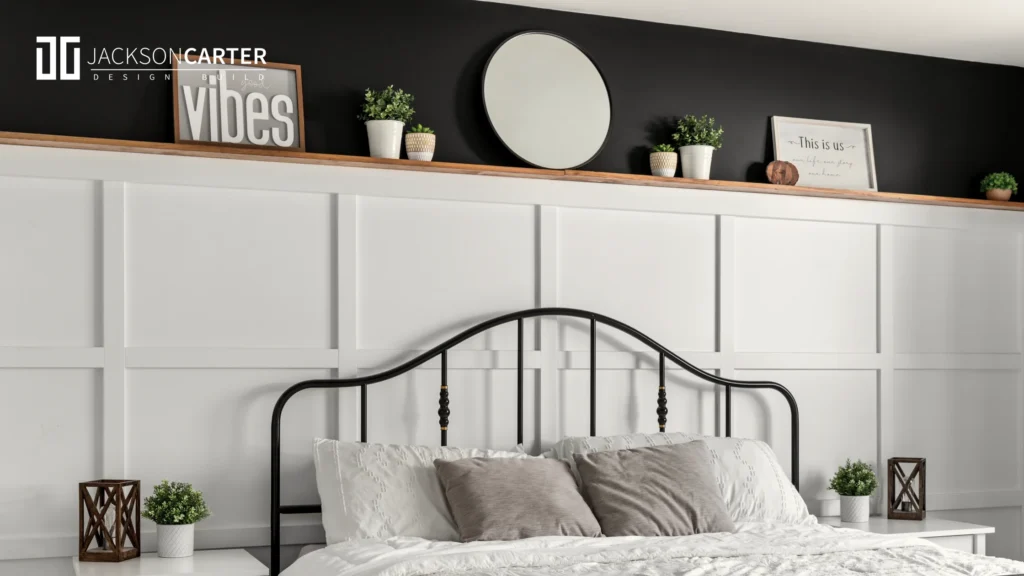
Wall paneling can elevate your bedroom’s architecture from modern vertical slats to classic wainscoting. Panels lend depth and structure, making even a simple paint color look more sophisticated.
How to Achieve It?
- Wainscoting Tradition: Pair white wainscoting with a deeper color on the wall above for a timeless look.
- Floor-to-Ceiling Panels: Consider full-height paneling to emphasize vertical space, especially in rooms with high ceilings.
- Bold Color Choices: Paint your panels in a striking hue—like emerald, navy, or plum—for an unexpected twist on traditional design.
- Texture Variation: Experiment with beadboard or shiplap panels for a cottage-like charm.
Quick Tips
- Pro Installation: Misaligned panels can ruin the look; hire a professional if you’re unsure.
- Minimalist Décor: Let the paneling be a focal point by keeping wall art minimal.
- Contrasting Trim: White or off-white trim can offset bold panel colors beautifully.
- Highlight With Lighting: Strategically placed sconces can make paneled walls glow.
13. Eclectic Energy: Go Eccentric
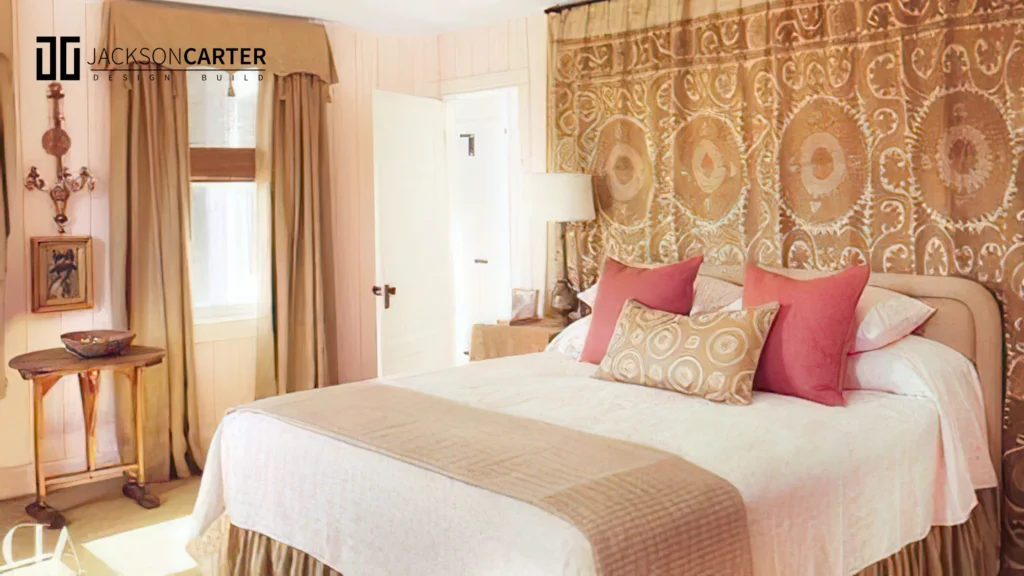
Eclectic style is all about layering diverse patterns, textures, and eras in a way that ultimately gives a sense of unison. It’s perfect for anyone who doesn’t want to adhere to a single design rulebook and loves mixing color and vibrancy.
How to Achieve It?
- Mix-and-match bedding: Combine different prints—like stripes, florals, or paisleys—but stick to a shared color palette.
- Global Influences: Incorporate Moroccan lanterns, African mud cloth pillows, or Japanese shibori textiles to enrich your space’s cultural tapestry.
- Collected Treasures: Display items collected from travel or thrift store hunts—eclectic rooms often tell a story about their owners.
- Unifying Hues: Ensure at least one color or design element repeats throughout the room to avoid chaos.
Quick Tips
- Foundation Neutrals: Ground bright colors and bold prints with a neutral rug or walls.
- Scale Consideration: Varying patterns in different scales (small, medium, large) can prevent visual clash.
- Personal Art: Eclectic spaces display original artwork or handcrafted pieces perfectly.
- Intentional Placement: Though eclectic style embraces variety, place objects thoughtfully to prevent a cluttered feel.
14. Underfoot Drama: The Statement Rug
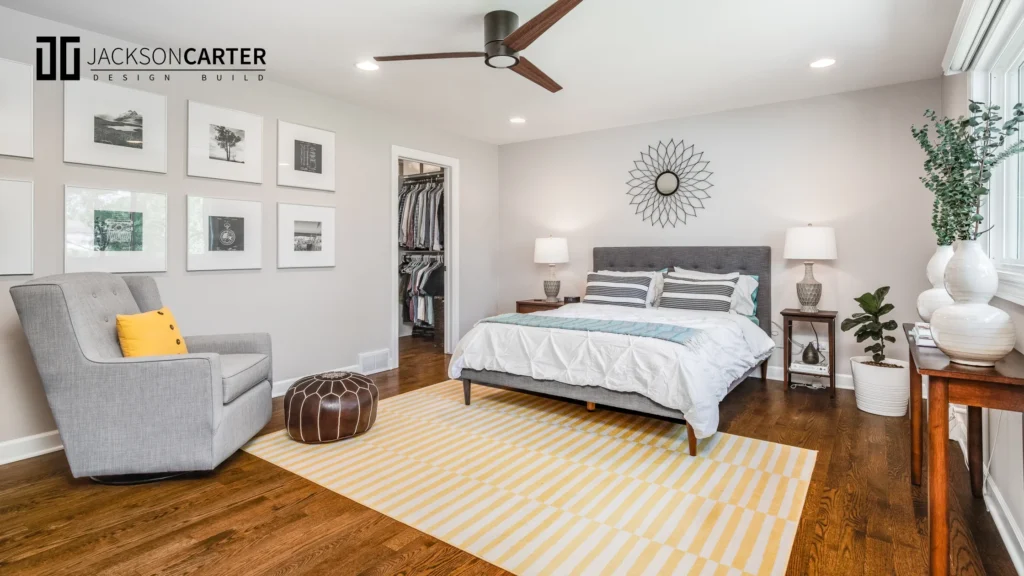
A well-chosen rug can be the visual anchor of your master bedroom, injecting color, pattern, or texture that ties all other elements together. Whether you opt for a traditional Persian rug or a modern geometric design, it becomes a focal point that sets the room’s tone.
How to Achieve It?
- Oversized Elegance: If space allows, choose a rug large enough so your bed and nightstands all fit comfortably on it. This creates a unified look.
- Texture Play: A shag or high-pile rug can add warmth and comfort, especially beneficial for cold winter mornings.
- Layering Rugs: For visual depth, combine a large, neutral base rug with a smaller, patterned, or colorful rug on top.
- Rug Materials: Wool is luxurious and durable, while synthetic blends can be more budget-friendly. Jute or sisal rugs add natural texture.
Quick Tips
- Color Coordination: Pick a rug that complements existing bedding and furniture, tying them together visually.
- Proper Placement: Typically, you’ll want at least the front legs of the bed on the rug.
- Consider Maintenance: If you have pets or kids, choose easy-to-clean or stain-resistant rugs.
- Define Zones: In larger bedrooms, use rugs to define separate areas, such as a seating nook.
15. Snug Sanctuary: Alcove for Comfort
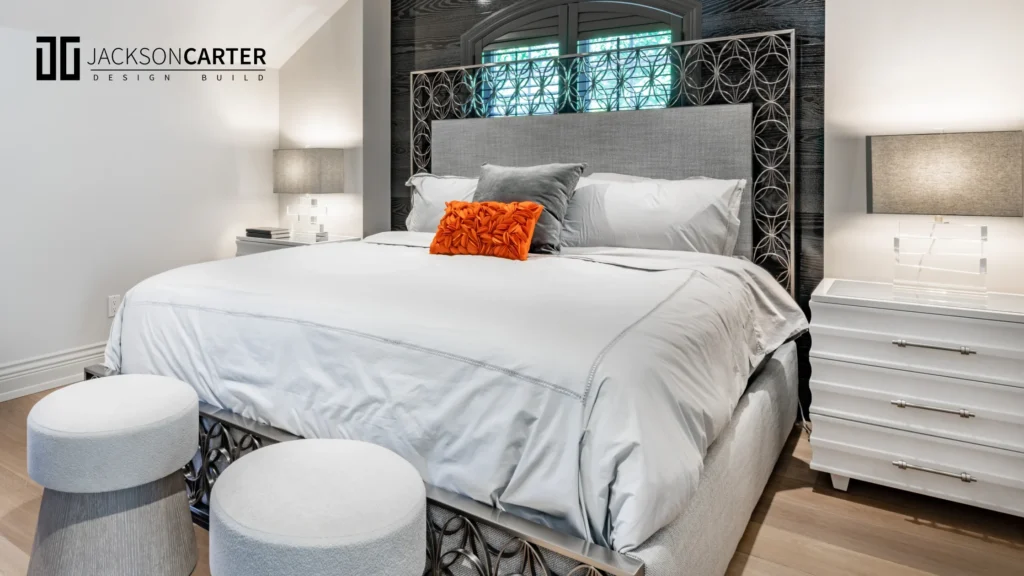
A bedroom alcove can serve as a reading nook, meditation corner, or even a mini lounge. Carving out this dedicated spot can make your master bedroom feel like a suite within your home, providing a private retreat for quiet moments.
How to Achieve It?
- Built-In Seating: If space allows, install a built-in bench with plush cushions for a cozy, window-seat feel.
- Floating Shelves: These can house books, plants, or decorative items. Pair them with a small reading lamp for evening relaxation.
- Accent Color: To set the alcove apart from the main room, paint or wallpaper it in a complementary but distinct shade.
- Soft Lighting: Fairy, wall sconces, or small table lamps can create an inviting, restful ambiance.
Quick Tips
- Comfortable Textiles: Layer cushions and soft throws to make the alcove extra inviting.
- Add a Tiny Table: If space permits, a small side table for a cup of tea or coffee elevates the nook’s functionality.
- Personalize: Hang art or photos in the alcove to give it a distinct identity.
- Consider Privacy: If you share the bedroom, a curtain or screen can provide secluded “me-time.”
16. Garden of Dreams: Botanical Wallpaper
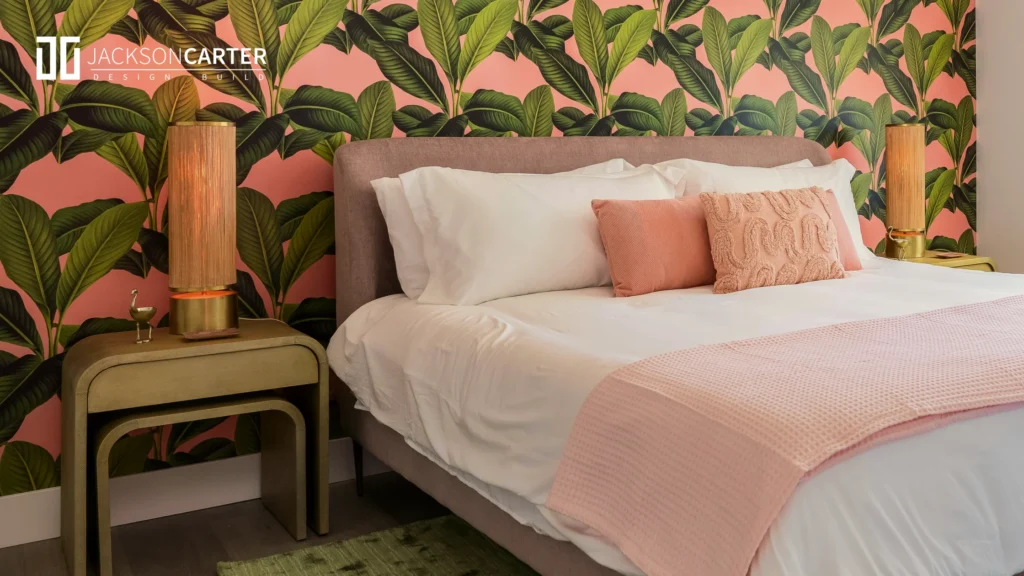
Botanical-themed wallpaper breathes life into your bedroom by mimicking the calming effect of nature. From simple palm fronds to lavish floral prints, the variety of designs available can energize or soothe, depending on your preference.
How to Achieve It?
- Scale of Print: Large, bold florals can lend a romantic, statement look, while smaller, subtle leaf motifs create a softer, more tranquil atmosphere.
- Material Selection: Opt for matte finishes in the bedroom to reduce glare, enhancing the cozy factor.
- Pair With Natural Elements: Wooden furniture, rattan light fixtures, or woven baskets tie in beautifully with botanical prints.
- Coordination: Echo a color from the wallpaper in your bedding or accent pillows for cohesive design.
Quick Tips
- Feature Wall Focus: If you’re unsure about going all-in, start with a single feature wall behind your bed.
- Keep Furnishings Simple: Let the wallpaper be the star by selecting furniture with clean lines and subdued colors.
- Add Real Plants: Indoor plants or vases of fresh flowers can amplify the botanical theme.
- Lighting Harmony: Soft, warm lights deepen the restful, garden-like atmosphere.
17. Monochrome Magic: Patterns in Unity
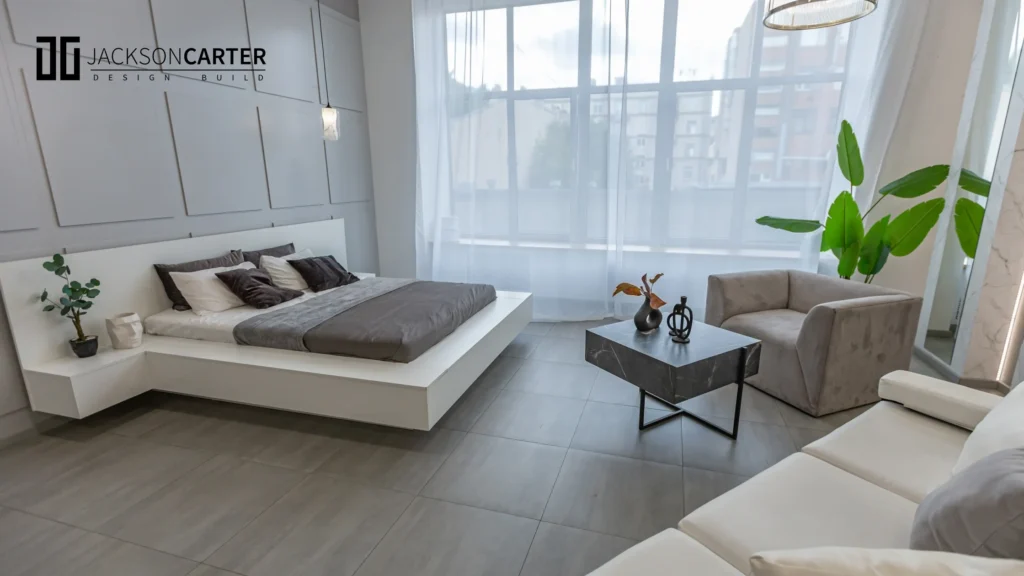
Picking one color family—like shades of gray, blue, or beige—and layering it throughout your space can result in a harmonious yet visually engaging bedroom. The trick is introducing different patterns, textures, and tones within that single-color scheme.
How to Achieve It?
- Varied Textiles: Combine velvet, linen, and cotton in the same color family for tactile diversity.
- Subtle Pattern Mix: Stripes, polka dots, and chevron prints can coexist if they share the same hue.
- Metallic or Wooden Accents: Break up the monotony by incorporating metallic or wooden pieces, which serve as complementary neutrals.
- Strategic Décor Pieces: Artwork in a similar color scheme but with bold, graphic shapes can add interest.
Quick Tips
- Play With Lightness and Darkness: Incorporate lighter and darker shades to avoid a flat look.
- Minimal Contrasts: If the room feels dull, add a small pop of a neighboring hue, like a pale pastel or a deeper neutral.
- Textured Paint: Consider paint finishes with texture (e.g., suede finish) for added dimension.
- Unified Simplicity: Keep decorative items minimal, ensuring the monochrome concept remains elegant.
18. Tucked Away: The Office Nook
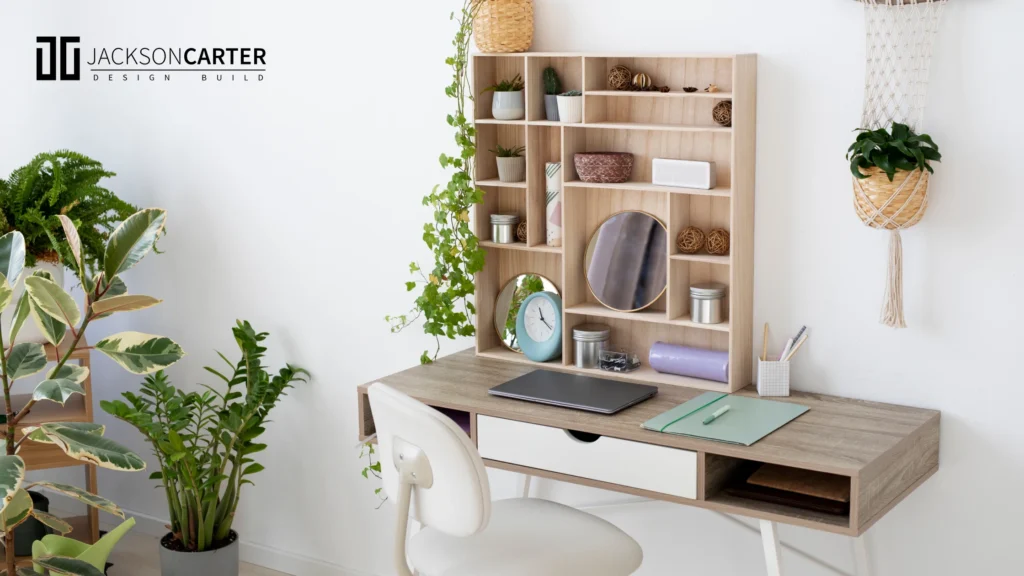
If you need to bring work into the bedroom (though many designers advise keeping work and sleep spaces separate), it’s essential to maintain aesthetics and practicality. A small desk and a comfortable chair, discreetly integrated, can meet your productivity needs without compromising the bedroom’s sanctuary-like feel.
How to Achieve It?
- Fold-Down Desks: If space is tight, opt for a wall-mounted, fold-down desk that can be tucked away when not in use.
- Stylish Storage: To hide papers and office supplies, use floating shelves or slim cabinets that match your bedroom’s design.
- Color Consistency: Paint or finish the desk the same color as your wall or trim for a seamless appearance.
- Chair Aesthetics: Pick an ergonomically sound chair that complements your bedding and décor.
Quick Tips
- Smart Lighting: A small adjustable lamp or overhead task lighting will reduce eye strain.
- Cable Management: Conceal wires behind furniture or use cable ties to keep your space neat.
- Organizational Tools: Desktop organizers or wall-mounted file holders help maintain a clutter-free surface.
- Weekend Transformation: If you want the bedroom to feel purely restful on weekends, store your work items out of sight.
19. Space Float: The Illusion of Floating Furniture
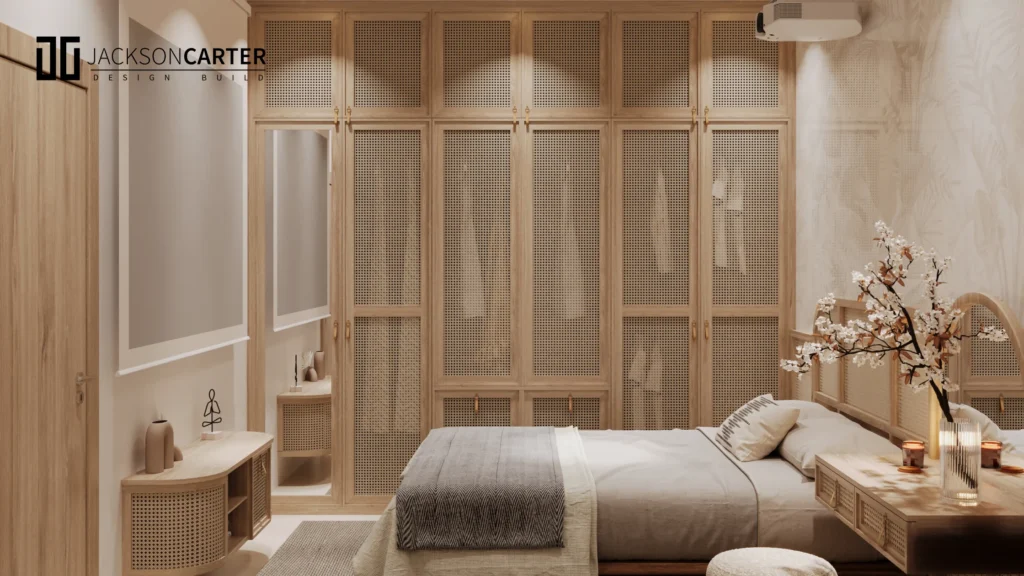
Mounting furniture on the walls—think floating nightstands, desks, or shelves—creates an airy, open feel. This trick looks contemporary and makes cleaning and rearranging a breeze.
How to Achieve It?
- Floating Nightstands: They free up floor space and can be designed with drawers or open shelving for additional storage.
- Suspend Your Bed: While more ambitious, a platform bed suspended from the ceiling or anchored to the wall can be a conversation piece.
- Visually Expand: In smaller rooms, floating designs let you see more floor area, which creates the illusion of spaciousness.
- Minimal Aesthetic: Floating furniture typically has clean, straight lines that fit perfectly into modern or Scandinavian styles.
Quick Tips
- Secure Installation: Use strong wall anchors or professional installation to ensure safety.
- Hide Wires: Carefully plan for electrical outlets to keep lamp or device cords concealed.
- Focus on Symmetry: If you have two floating nightstands, ensure they’re installed at the same height and distance from the bed.
- Keep It Clutter-Free: The open space beneath floating furniture makes clutter more noticeable, so maintain tidiness.
20. Sky’s the Limit: Decorated Ceilings
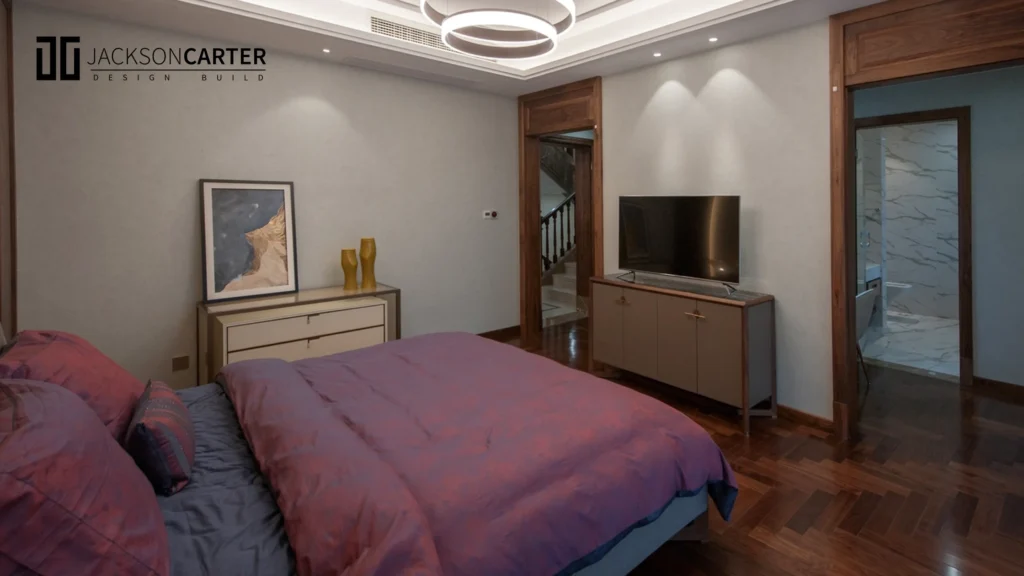
A boldly painted or patterned ceiling can inject personality into an otherwise subdued bedroom. This approach works especially well in rooms with tall ceilings, as it brings the upper space into focus.
How to Achieve It?
- Vibrant Hues: Electric blue, terracotta orange, or even a sunny yellow can instantly shift the room’s vibe when applied to the ceiling.
- Stencil Art: For artistic flair, use stencils or painter’s tape to create geometric or floral patterns.
- Coordination: Mirror a color from your bedding or curtains to ensure the ceiling design doesn’t feel out of place.
- Be Selective With Wall Decor: Let the ceiling be the room’s statement, and keep wall art more minimal.
Quick Tips
- Test Swatches: Paint a small section to gauge the color’s appearance in different lighting.
- Crown Molding: Installing decorative molding along the edges can frame your bold ceiling color.
- Balance the Room: If you choose a bright color overhead, keep your bedding and furniture subdued.
- Reflective Fixtures: Metallic or crystal chandeliers can catch and reflect color, enhancing the drama.
21. Curtain Call: The Elevated Headboard
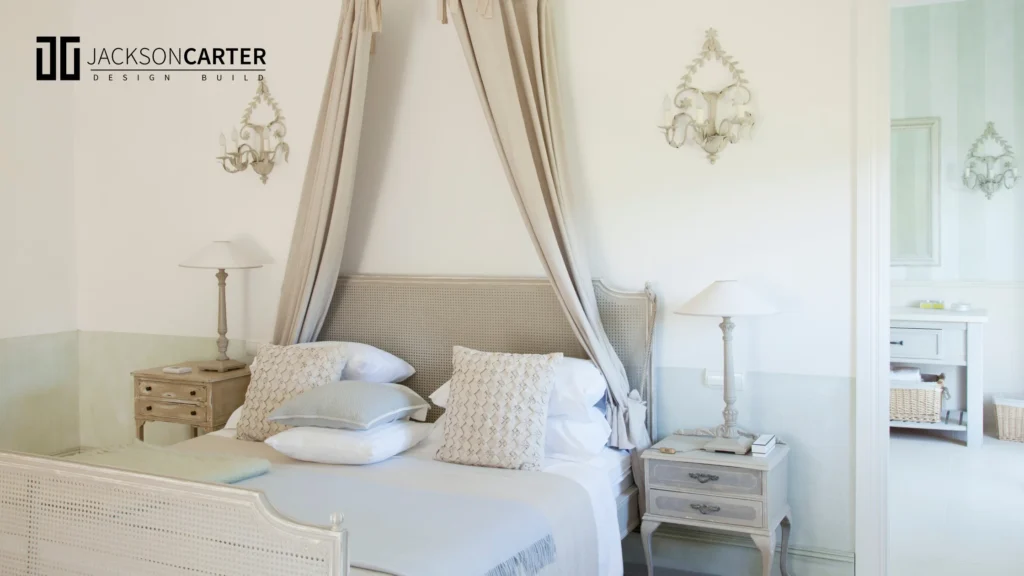
Hanging drapery or a curtain behind the bed can mimic a luxurious headboard effect. This easy and flexible décor solution can soften the room’s look and add height, especially if the curtain is installed closer to the ceiling.
How to Achieve It?
- Fabric Selection: Velvet offers a royal touch, while sheer linens create a breezy, ethereal atmosphere. The choice of fabric sets the tone.
- Dynamic Backdrop: You can swap out the curtain seasonally or as your style evolves, making it a perfect solution for design chameleons.
- Layering: Combine multiple layers of fabric—like a sheer front panel and a heavier panel behind—for dimension and insulation.
- Lighting Effects: String lights or LED strips hidden behind the curtain can provide a soft glow and highlight the drapery’s texture.
Quick Tips
- Hang It High: Placing the rod near the ceiling visually enlarges the space.
- Width Matters: For a more dramatic and luxurious look, make sure the curtain extends beyond the bed’s width.
- Coordinate: Match or complement the curtain color with your bedding or accent pillows.
- Hardware Style: Ornate rods or minimalistic rails can drastically change the drape’s overall impact.
22. Seamless Storage: Built-In Wardrobe
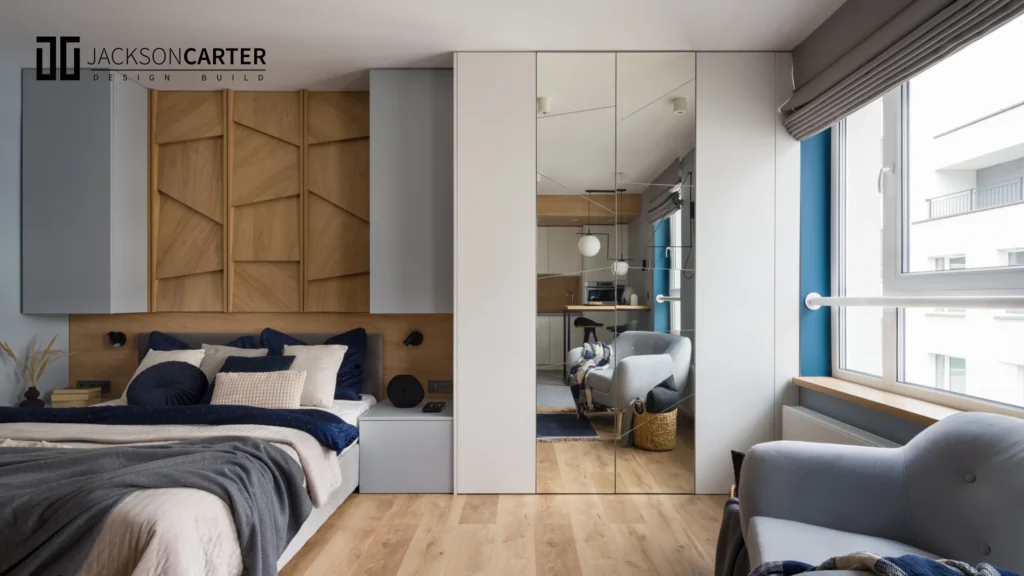
Built-in wardrobes offer a sleek look and ample hidden storage, keeping clutter at bay. By customizing them to your bedroom’s proportions, you can make the most of every inch of space.
How to Achieve It?
- Mirrored Doors: These disguise storage and reflect light, making the room appear larger.
- Open Shelving Sections: Combine closed wardrobes with open niches for display items like decorative vases or houseplants.
- Lighting Integration: LED strips inside the wardrobe or along its edges make it easier to locate items and add a futuristic flair.
- Coordinated Finishes: Whether you prefer wood grain, glossy white, or a painted surface, match it to the room’s existing décor for a cohesive look.
Quick Tips
- Floor-to-Ceiling: Maximize vertical space and avoid dust-collecting gaps on top.
- Organize Internally: Utilize pull-out drawers, hanging rods, and dividers for efficient organization.
- Sliding Doors: These are especially helpful in tighter rooms where swinging doors might be obstructive.
- Handle Choices: Sleek, recessed handles or push-to-open doors can enhance a minimalist vibe.
23. Headboard Gallery: Curated Moments
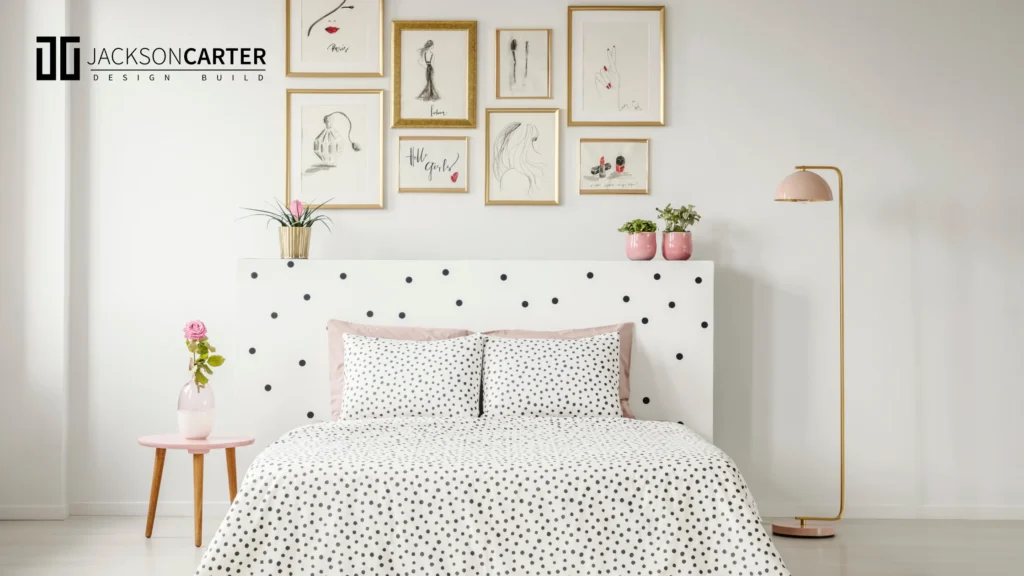
Transform the area behind your bed into a gallery wall that expresses your tastes and memories. This could feature a blend of personal photographs, artwork, or sculptural elements.
How to Achieve It?
- Theme Consistency: To keep the look cohesive, choose a unifying element—like black-and-white photography or coastal-inspired artwork.
- Mixed Media: Combine framed artwork with mirrors, decorative plates, or macramé hangings to add variety.
- Gallery Lighting: Small picture lights or LED strips can highlight focal frames and add ambience.
- Shelving Option: Install narrow picture ledges that allow you to swap out frames easily whenever you want a refresh.
Quick Tips
- Layout Planning: Arrange the pieces on the floor first or use paper cutouts on the wall to determine placement.
- Vary the Sizes: Mix big statement pieces with smaller ones for visual interest.
- Consistency in Framing: Use matching or complementary frame styles to have a more polished look.
- Art at Eye Level: Typically, the artwork’s center should be around eye level for best viewing.
24. Accent & Amaze: The Power of One Wall
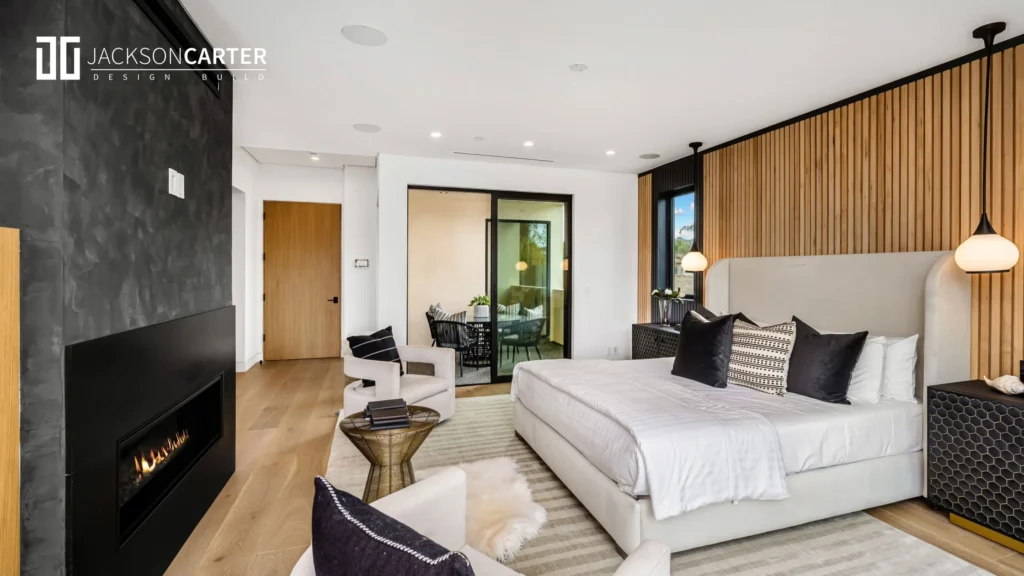
An accent wall painted or wallpapered in a contrasting color is one of the simplest and most effective ways to add depth to a master bedroom. It can serve as a backdrop for the bed, anchoring the room’s aesthetic.
How to Achieve It?
- Bold vs. Subtle: Opt for a highly saturated hue or a dramatic pattern if you want a big impact. For a gentler approach, choose a color just a few shades darker than your primary palette.
- Texture Options: Apart from paint or wallpaper, consider reclaimed wood planks, stone veneer, or 3D wall panels for a tactile statement.
- Art and Décor Placement: Let the accent wall shine by keeping art and wall décor minimal, or choose pieces that complement rather than clutter.
- Matching Accents: Mirror the accent color in throw pillows, bed runners, or small decorative objects.
Quick Tips
- Complementary Shades: Use the color wheel to pick a hue that complements your existing scheme.
- Balance in the Room: Stick to one accent wall; multiple competing walls can be visually confusing.
- Transition Corners: Paint corners carefully to avoid messy lines where accent meets the adjoining wall.
- Refine with Lighting: Spotlights or sconces on the accent wall can bring out its depth.
25. Sofa So Good: Bed-End Seating
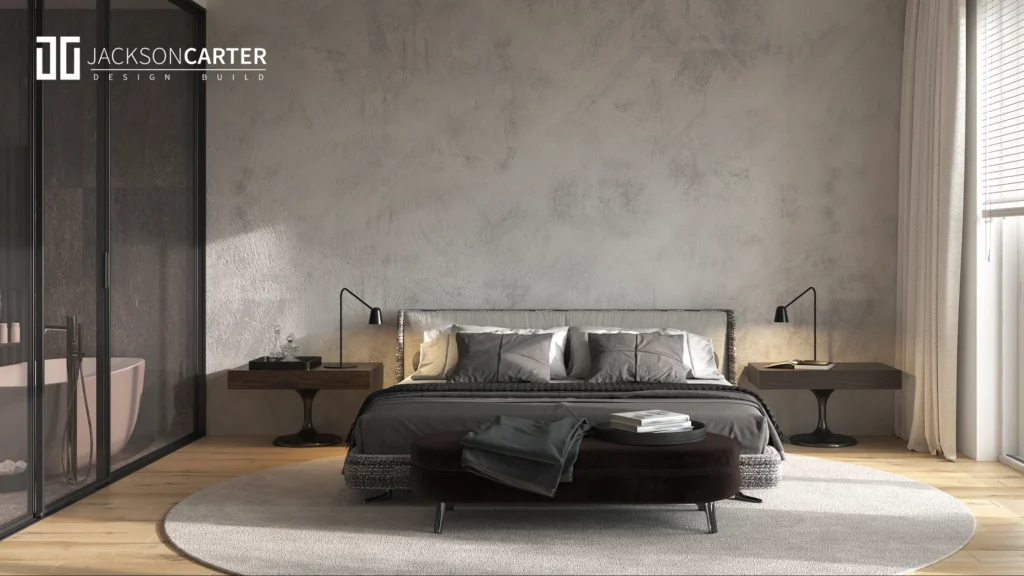
Adding a bench, loveseat, or even a pair of armchairs at the foot of your bed is both functional and stylish. It provides a spot to put on shoes, place an extra blanket, or simply relax without messing up your carefully arranged bedding.
How to Achieve It?
- Storage Bench: Opt for a bench with a lift-up top to store linens, pillows, or seasonal items.
- Styling Opportunities: A small throw blanket or decorative cushion on your seating area can tie it into the rest of the room’s color palette.
- Material Considerations: Leather benches offer a sleek, modern look, while upholstered ones can be cozy and inviting. Wooden benches with cushions strike a rustic-modern balance.
- Proportion Matters: Make sure the width of your seating doesn’t exceed the bed’s width, and leave ample walkway space.
Quick Tips
- Coordinate Fabrics: If you have a patterned duvet, choose a bench in a solid or complementary fabric.
- Comfort Factor: If you plan to sit here often, invest in plush cushions or ergonomic designs.
- Blend or Contrast: A bench that seamlessly blends with the bed’s style can look cohesive, while a contrasting piece can be a focal point.
- Add a Side Table: If space allows, a small side table next to the seating can hold books or beverages.
Your master bedroom is more than just a place to sleep—it’s a personal retreat that can refresh your mind, showcase your style, and infuse your daily routine with tranquility. If you’re drawn to understated palettes with natural textures or prefer bold hues and dramatic accents, there’s a design concept suited to every taste.
Now that you’ve gathered plenty of inspiration, developing a unified plan is time. Focus on one or two standout ideas, collect your materials, and refine your color palette.
Remember that small details—lighting, hardware, and textiles—bring the entire design together. With thoughtful intention and a bit of creativity, you’ll soon create a master bedroom that reflects your individuality and becomes a soothing oasis for years to come.
Reimagine Your Bedrooms into Restful Oasis with Jackson Carter Design Build

Designing a home that blends style and practicality is completely achievable with the right team. At Jackson Carter Design Build, we excel at turning houses into personalized dream homes shaped around your lifestyle and vision.
Backed by decades of industry experience, our team prides itself on delivering outstanding craftsmanship and meticulous attention to detail. Whether you’re updating a single room or completely reimagining your living space, we’ll ensure every area inspires and enhances your daily life.
Our offerings include:
- General Contracting: Comprehensive project oversight from start to finish
- Custom Home Builds: One-of-a-kind residences built entirely from the ground up
- Home Additions: Seamlessly integrated expansions to increase your living space
- Kitchen Renovations: Functional layouts and eye-catching finishes for the heart of your home
- Basement Finishing: Transform unused areas into versatile, comfortable rooms
- Bathroom Remodeling: Luxury and style in your everyday routine
- And More…
Contact us today to schedule a consultation and embark on your journey toward a more beautiful home!

